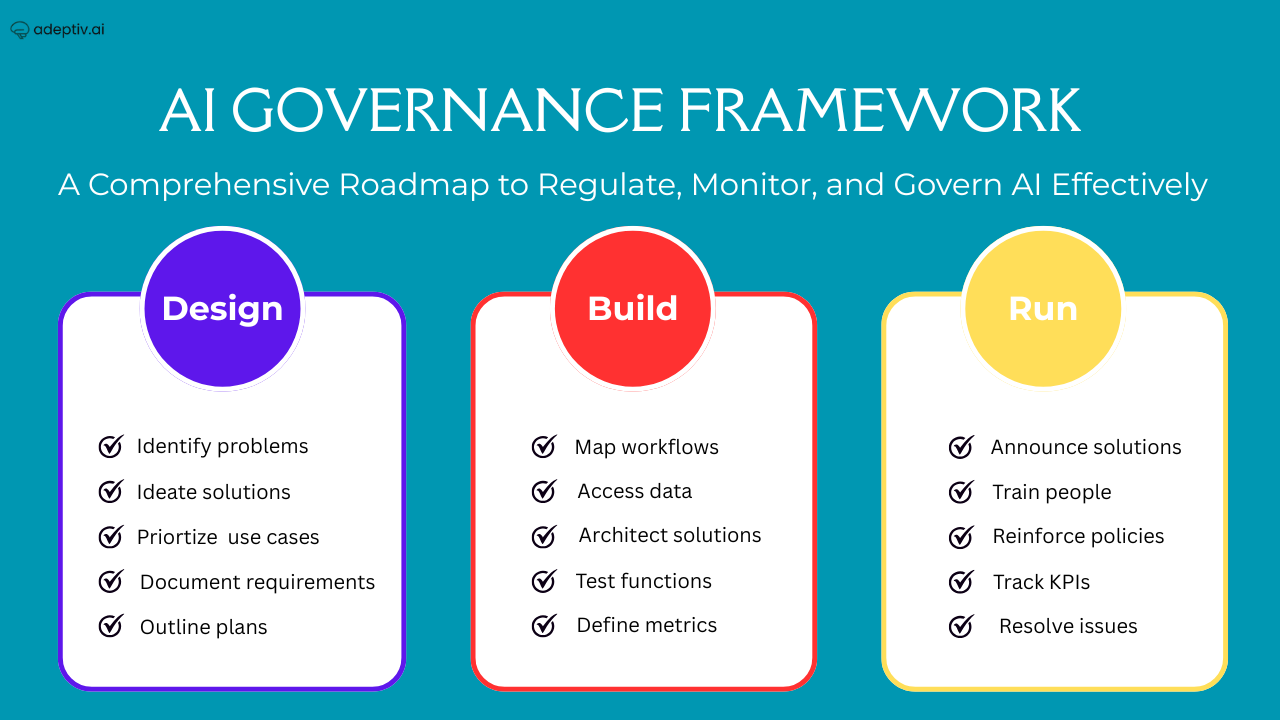At a Glance
- Core Foundations of AI Governance — Understand the frameworks, principles, and global standards shaping trustworthy AI systems.
- Key Terminologies Simplified — Explore the 10 most essential terms every AI leader, policymaker, and developer should know.
- Compliance Meets Responsibility — Learn how Responsible AI and Governance frameworks work hand-in-hand to ensure ethical, compliant innovation.
- Real-World Relevance — Discover how leading organizations are adopting AI governance models to manage risk and boost digital trust.
- Strategic Takeaways — Get actionable insights to build, assess, and govern AI responsibly within your organization.
Introduction
In 2025, AI development has reached a tipping point. The global AI market is now estimated at USD 638.2 billion and is forecast to swell to over USD 3.68 trillion by 2034. As AI becomes deeply embedded in business operations, it’s no longer enough to just “adopt AI” — how you adopt it will determine whether you build trust or collapse under risk.
Many organizations still conflate two critical pillars: Responsible AI and AI Governance. Yet they play distinct, complementary roles. Responsible AI embeds ethics into models and decision-making, while AI Governance is the structural scaffolding that enforces, monitors, and scales those ethics across the enterprise.
In this article, we’ll unpack these two concepts, show why both are vital (not optional), and present a roadmap for integrating them — with real numbers, regulatory insight, and examples you can use now.
Responsible AI vs AI Governance: What’s the Difference?
Responsible AI — Ethics in Action
Responsible AI is about embedding values and protections within the models, pipelines, and user interactions. Think of it as the development-level guardrails: fairness, transparency, privacy, accountability, safety. Without this, even well-intentioned AI can amplify bias, mislead users, or violate rights.
Take ethical AI principles such as those cited by Harvard: fairness, transparency, accountability, privacy, and security. Responsible AI ensures these principles aren’t just theoretical — they become built-in checks in the code.
AI Governance — The Oversight Architecture
If Responsible AI is the engine, AI Governance is the chassis and control surfaces. Governance encompasses policies, oversight, frameworks, roles, audits, escalation, compliance integration, and enforcement mechanisms. It’s the system that ensures ethical practices are followed consistently across all AI initiatives.
IBM succinctly frames it: AI Governance refers to “processes, standards and guardrails that help ensure AI systems … remain safe, ethical and respect human rights.” A good governance model scales ethical intent beyond individual teams — into the whole organization.
Why both are required
- Responsible AI without governance → islands of safe models.
- Governance without responsible AI → hollow compliance without real trust.
- Both are necessary to win regulatory confidence, stakeholder trust, and sustainable AI ROI.
The Stakes: Facts, Trends & Signals
- AI Investment Surge: In 2024, U.S. private AI investment reached USD 109.1 billion, dwarfing China’s USD 9.3B.
- Organization hiring shifts: 13% of enterprises now report hiring AI compliance specialists, and 6% hire AI ethics specialists.
- Regulatory pressure rising: Major jurisdictions are rolling out AI laws and oversight regimes. According to recent reviews, transparency and accountability are the most cited principles in AI governance literature.
- Market growth validating need: The global AI market continues climbing—Morgan & GrandView data estimate ~USD 391B in 2025, heading toward multi-trillion valuations.
These signals suggest two things: the cost of failure is mounting, and organizations that operationalize ethics + governance will differentiate themselves in value, trust, and longevity.
How to Build Both: Roadmap & Best Practices
Here’s a breakdown of how to operationally integrate Responsible AI and AI Governance in your org, step by step.
1. Start with Responsible AI Foundations
- Define your AI ethics principles (fairness, safety, transparency, privacy).
- Build model-level guardrails: bias tests, adversarial robustness, data validation, privacy-preserving techniques.
- Use tools like SHAP/LIME, counterfactuals, and post-hoc explainability to keep decisions interpretable.
2. Layer Governance Frameworks
- Adopt a governance framework: ISO 42001 (AI management standard), NIST AI RMF, or EU AI Act (for applicable regions).
- Create an AI steering committee (cross-functional: legal, tech, operations).
- Define roles: AI risk officer, data steward, compliance lead.
- Design approval gates (AI impact assessments, audits).
3. Classify & Tier AI Systems
- Use risk tiers: minimal, limited, high, unacceptable (mirroring EU AI Act style).
- Apply stricter governance to high-risk systems (e.g., financial decisions, hiring, healthcare).
- Embed review, human-in-the-loop, or kill switches accordingly.
4. Monitoring, Logging & Auditability
- Build a registry of models & datasets with versioning, lineage, input/output logs.
- Monitor drift, fairness metrics, performance degradation.
- Schedule internal audits plus external reviews when needed.
5. Governance as Living System
- Review policies as AI evolves (e.g., generative models, new compute thresholds).
- Use feedback loops from users, impacts, incidents.
- Update principles and governance documents dynamically.
Business Implications & Use Cases
Use Case: Hiring / Recruitment
- 83% of companies now use AI for candidate screening.
- Without bias mitigation, AI can replicate systemic inequities (e.g., underrepresent women, minorities).
- Governed systems require vendor transparency, audit trails, candidate appeal paths.
Use Case: Banking & Credit
- AI-based loan scoring must ensure fair lending (avoiding disparate impact).
- Governance ensures model validations, audit trails, and human overrides in borderline cases.
- Missteps can lead to regulatory fines or reputational damage.
Use Case: Healthcare
- AI diagnostics require explainability, safety thresholds, oversight from medical professionals.
- Governance frameworks specify when systems need human validation or fallbacks.
Across cases, the organizations that built both ethical AI designs and robust governance tend to outperform in trust, adoption, and resilience.
Conclusion
In 2025, AI isn’t just a technical challenge — it’s an existential one for business trust, governance, and reputation. Responsible AI and AI Governance aren’t competing choices — they’re two halves of a whole.
Embed ethics into your models. Wrap them in governance. Continuously monitor. That’s how you build AI that’s powerful, trusted, and sustainable.
Are you ready to transform your AI journey from risk to resilience? Explore how Adeptiv AI helps organizations merge ethical design and enterprise governance.
1. Isn’t compliance enough — why add Responsible AI?
Compliance sets minimum rules; Responsible AI goes further — embedding ethics, fairness, and safety at the core. It’s what bridges legal with trustworthy.
2. Which should a startup focus on first?
Begin with Responsible AI — establish your ethical culture and safe model practices. As you scale, build governance around it so safeguards don’t lag.
3. How do I choose between ISO 42001, NIST, or EU AI Act?
It depends on jurisdiction and risk profile. Use whichever your major markets enforce (e.g. EU AI Act in Europe). Use NIST/ISO as baseline global standards.
4. How often should I audit or review AI systems?
At minimum quarterly for high-risk systems; semi-annually for moderate; annually for low-risk. Also trigger audits on major updates.
5. Can an external audit suffice?
External audits add credibility, especially in regulated sectors. But they should complement, not replace, internal governance and continuous oversight.



